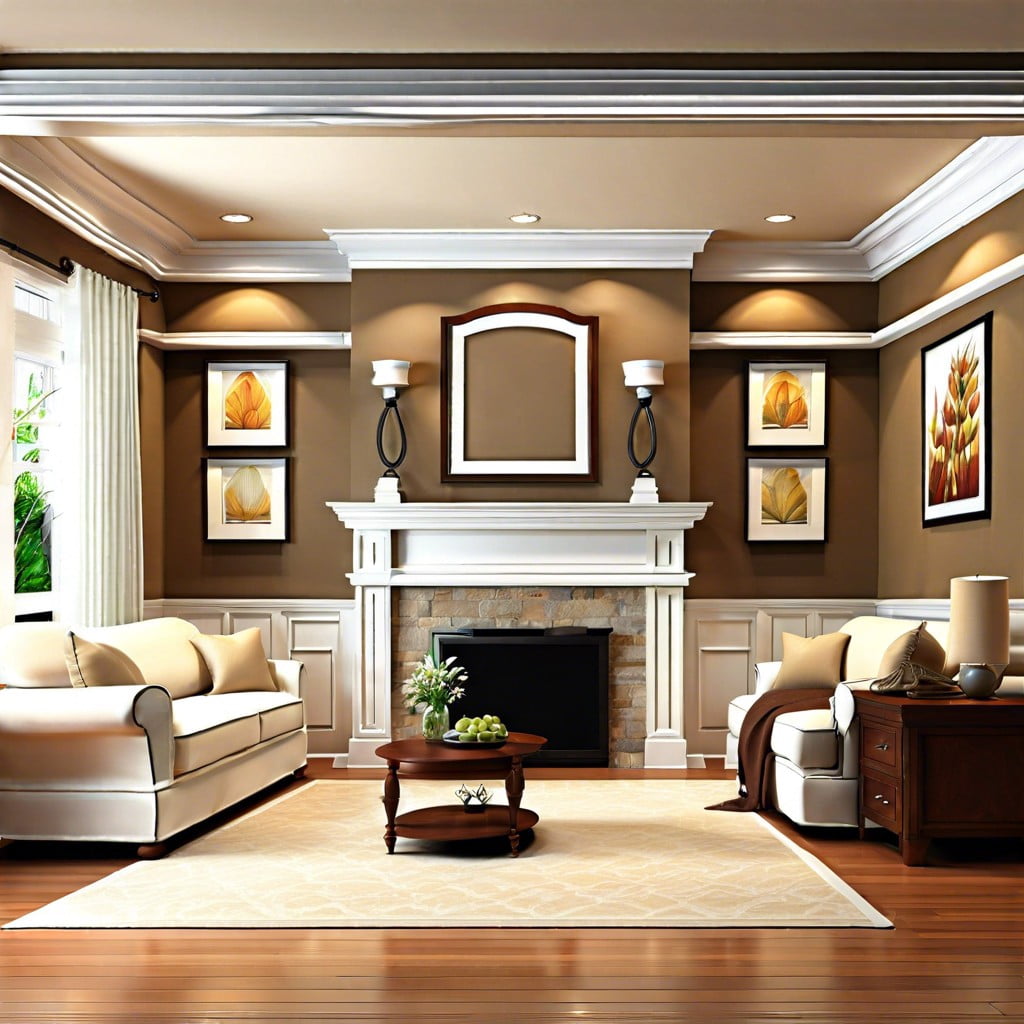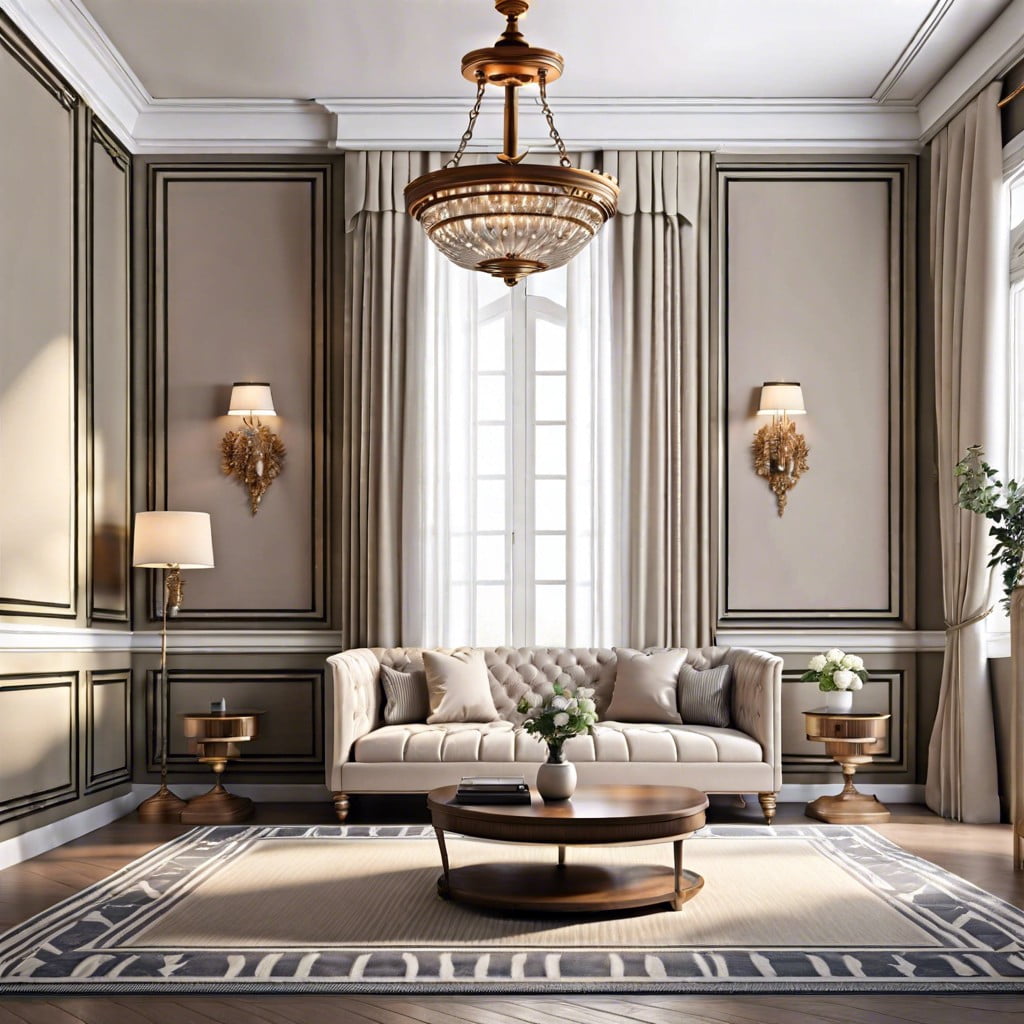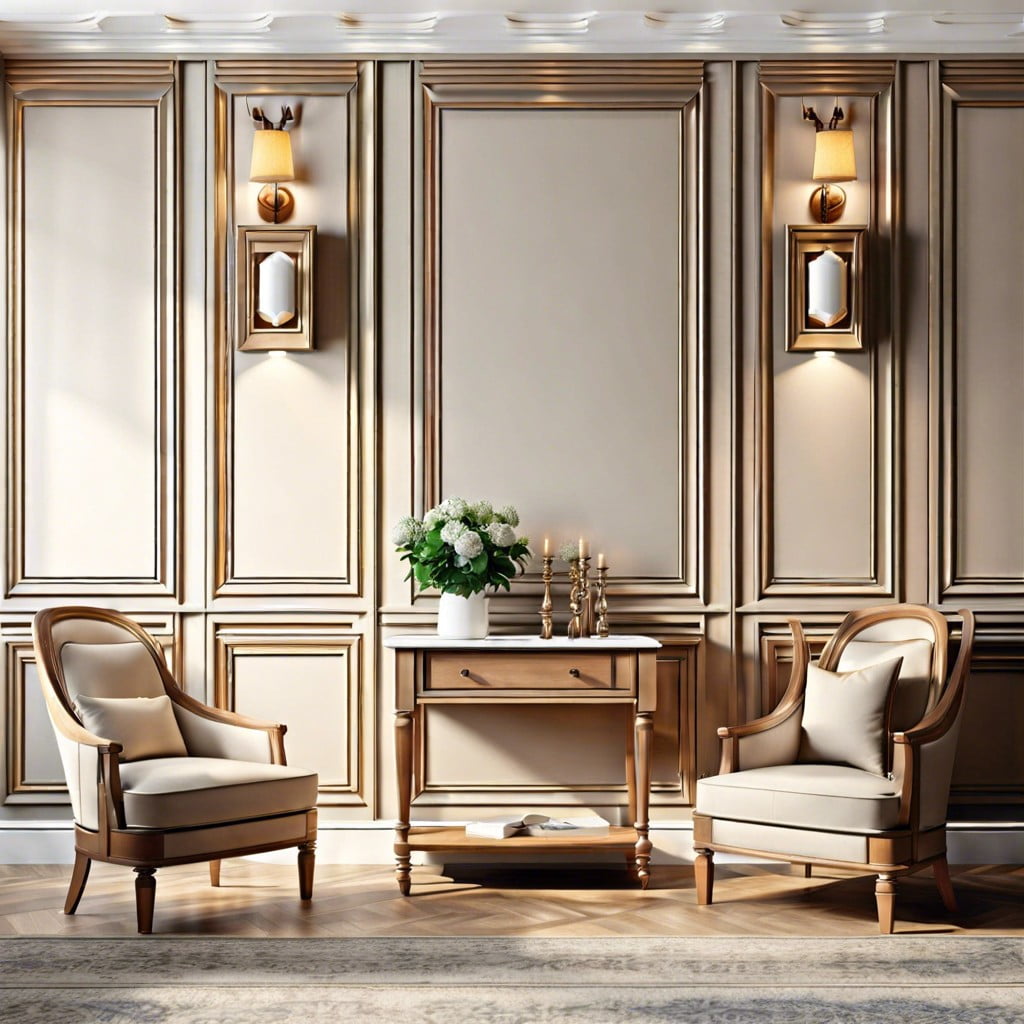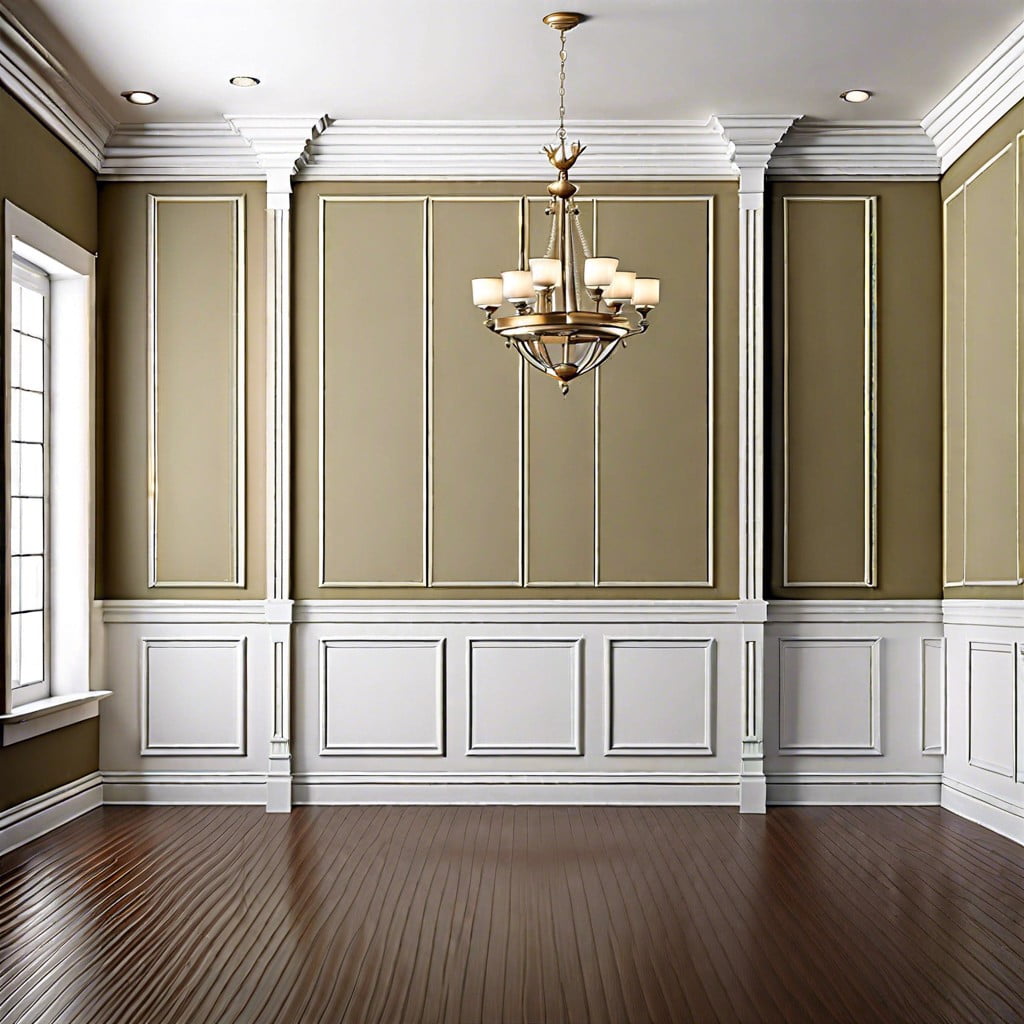Last updated on
Boost the aesthetic appeal of your home because mastering the art of choosing and installing wainscoting and crown molding is less complicated than you think.
Key takeaways:
- Different types of crown molding: classic, cove, dentil, modern, flexible.
- Benefits of crown molding: enhances aesthetic, adds elegance, increases perceived height.
- Various wainscoting styles: picture frame, board and batten, raised panels, flat-panel, beadboard, overlay.
- Choosing wainscoting for different rooms: consider function, ceiling height.
- Materials used in wainscoting and crown molding: wood, MDF, PVC, polyurethane, plaster.
Types of Crown Molding

Crown molding comes in a variety of shapes and materials to suit different architectural styles and preferences. Here’s a streamlined guide to the most common types you’ll encounter:
- Classic: Features traditional curves and patterns, adding a touch of elegance to any room.
- Cove: Simpler than classic designs with a concave profile, cove molding provides a subtle transition between wall and ceiling.
- Dentil: Characterized by small, repeating blocks, it’s ideal for adding a historical look to your space.
- Modern: Clean, minimalist lines define this style, perfect for contemporary homes.
- Flexible: Made of a malleable material such as vinyl, it’s designed for curved walls and unconventional lines.
Each style can dramatically alter the ambiance of a room, so your choice should complement the home’s existing design elements. Consider the ceiling height, the room’s size, and the overall aesthetic you aim to achieve when selecting your crown molding.
Benefits of Crown Molding

Crown molding elevates the aesthetic value of a room by providing a smooth transition between the wall and ceiling. This architectural feature adds a touch of elegance and can make a space feel more polished and complete. It can also increase the perceived height of a room, creating an illusion of more space, which is particularly beneficial in homes with lower ceilings.
Moreover, it serves a practical purpose by concealing any imperfections where walls meet ceilings, which can be difficult to finish perfectly during construction. As an investment for homeowners, it can also enhance property value, as it is often sought after for its classic, finished look—a detail that can set a property apart in the real estate market.
Wainscoting Styles

Embrace the charm of traditional panels or the sleekness of modern designs with various wainscoting styles to enhance your walls.
Picture frame wainscoting offers a classic look with rectangular frames, ideal for adding character in dining rooms or hallways.
Board and batten provide a more structured feel with vertical boards, excellent for a touch of farmhouse flair.
Raised panels are the epitome of elegance, with their elevated centers casting subtle shadows for a sophisticated vibe, perfect in formal areas.
Flat-panel wainscoting carries a minimalist aesthetic, aligning with contemporary spaces through clean lines.
If your aim is for a more decorative approach, beadboard wainscoting with its vertical grooves imparts a cozy, cottage-like feel.
For a daring, luxurious touch, consider incorporating an overlay wainscoting style where intricate molding adds depth and dimension.
Each style dictates the room’s overall feel and can be painted or stained to match your existing decor.
By choosing one that compliments your space, you can transform plain walls into noteworthy features.
Choosing Wainscoting for Different Rooms

Deciding on wainscoting for each room involves matching form and function. Bathrooms benefit from PVC or tile wainscoting due to their water resistance.
Opt for raised-panel or beadboard styles in dining rooms for a classic look, ideally in solid woods like oak or maple.
For living spaces, consider flat panels for a contemporary feel or judges paneling for a traditional ambiance.
In hallways, where traffic is high, durable materials such as MDF can withstand the hustle and bustle.
Keep in mind the room’s ceiling height; taller rooms can handle higher wainscoting without feeling cramped, enhancing the space’s grandeur.
Always ensure the style complements your home’s overall aesthetic for a cohesive look.
Materials Used in Wainscoting and Crown Molding
Selecting the right material for your wainscoting or crown molding project can set the stage for the look and longevity you’re aiming for. Here’s a quick dive into popular options available:
- Wood: A classic choice that offers warmth and can be stained or painted to your preference. Ideal for a traditional aesthetic, it’s durable but can be pricier and may require more maintenance.
- MDF (Medium Density Fiberboard): An affordable, paint-friendly option that’s easy to work with. MDF won’t warp and is great for a smooth finish, though it’s not as resilient when it comes to moisture.
- PVC: Perfect for bathrooms or high-moisture areas due to its water resistance. It’s also insect-proof and can mimic the look of painted wood without the risk of rot.
- Polyurethane: Lightweight and less prone to damage or environmental wear than wood. It cuts smoothly and is typically ready for paint, making it a hassle-free choice.
- Plaster: Often found in historic or high-end homes, plaster crown molding is revered for its detail and grandeur. It’s substantial and sturdy but requires skilled installation and is at the higher end of the price spectrum.
Remember, consider the room’s function, the climate you live in, and whether you want to invest time in maintenance when choosing your materials. The right pick can beautifully enhance the character of your space.
Installation Tips for Crown Molding
Measuring Accurately:
- Use a tape measure to determine the length of each wall.
- Remember to account for the angles, especially in cases where walls meet at other than 90 degrees.
Cutting Methods:
- Miter saws are ideal for precise angle cuts.
- Coping saws help for tighter fits at inside corners.
Finding and Marking Studs:
- Use a stud finder to locate studs for secure attachment.
- Mark stud positions lightly with a pencil where the molding will be nailed.
Corner Technique:
- Start with the least visible corner of the room to practice.
- Cut the molding at a 45-degree angle for a mitered joint.
Nailing:
- Use finishing nails and a nail set to attach the molding.
- Space nails about 16 inches apart or into every other stud.
Sealing Gaps:
- Caulk any gaps between the molding and the ceiling or wall for a seamless look.
- Paintable caulk allows for easy touch-ups.
Practice Patience:
- Take your time to measure twice and cut once.
- Proceed slowly with each step to ensure the best fit and finish.
Installation Tips for Wainscoting
For a smooth wainscoting installation, begin by measuring the room accurately to calculate how much material is needed. Remember, it’s always better to buy a little extra for any unforeseen errors or adjustments.
Prepare your walls by ensuring they are clean, dry, and smooth. Any imperfections may show through the wainscoting, so take the time to patch and sand as necessary.
Consider the room’s humidity when selecting materials. For example, MDF is more affordable but may not be suitable for bathrooms or other high-moisture areas, whereas PVC or solid wood might be better choices.
Mark the wall where the top of the wainscoting will go, ensuring the line is level all the way around the room. This serves as your guide to keep panels straight during installation.
When cutting panels to size, use a fine-tooth saw for cleaner edges. If using wood, remember to account for potential expansion and contraction.
Apply construction adhesive to the back of the panels for additional hold, then secure them to the wall with finish nails. This two-pronged approach ensures a durable mount.
For corners, miter the edges for a seamless fit. If walls are not perfectly square, cope the joints to accommodate any discrepancies.
Hide seams and nail heads with wood filler, then sand lightly once dry to create an even, paintable surface.
Finally, paint or stain the wainscoting to your preference, considering the existing room decor and overall aesthetic you wish to achieve.
Wainscoting Vs. Beadboard
Understanding the distinction between wainscoting and beadboard is essential when considering wall treatments. While both can elevate a room’s aesthetic, beadboard offers a textured vertical stripe pattern, creating a more casual, cottage-like feel. Traditionally, beadboard consists of narrow wood strips with a raised bead along each edge, fitting snugly together for a seamless look.
Conversely, wainscoting generally refers to paneling that extends partway up a wall. Its origins are deeply rooted in functionality, initially serving to protect walls and provide insulation. Today, it comes in various styles from raised to flat panels, with opportunities for customization in panel size and design patterns.
In essence, while beadboard can qualify as a type of wainscoting, not all wainscoting is beadboard. Your preference may hinge on whether you’re after a classic, sophisticated ambiance that wainscoting offers or a cozy, rustic charm that comes with beadboard. Selecting between the two will depend on your desired visual impact and the character you envision for your space.
Maintenance and Care of Wainscoting and Crown Molding
To keep your wainscoting and crown molding looking pristine, periodic cleaning and upkeep is a must. Dust regularly using a soft cloth or a duster, reaching up to the crevices of the crown molding to prevent build-up. For more thorough cleaning, a damp cloth can wipe away grime – just be sure to dry the area to avoid moisture damage.
When it comes to painted surfaces, touch-ups may be necessary to cover scuffs or chips. Keep some leftover paint for this purpose. For stained or natural wood, a wood cleaner can restore shine and protect the finish from drying out.
Although both features are designed for durability, inspect them annually for signs of wear. Look out for peeling paint, cracks, or any separation from the wall. Early detection makes repairs simpler and less costly.
If moisture is a concern, especially in bathrooms or kitchens, check that wainscoting and crown molding are properly caulked and sealed. This prevents water intrusion, which can lead to swelling or mold issues.
With these care methods, your decorative details will maintain their beauty and continue to elevate your home’s aesthetic for years to come.
Cost Considerations
When budgeting for decorative molding, several factors affect the price. Material choice is paramount—MDF is economical, while hardwoods like oak or cherry are pricier but add a luxe finish. Complexity of design can also sway costs; simple profiles are less expensive than intricate patterns. Labor expenses hinge on project scale and intricacy, with DIY installation cutting down on costs significantly. Remember to factor in additional supplies like paint, nails, and caulk. Prioritize elements most visible or impactful in your space to allocate funds effectively. Always seek multiple quotes to ensure competitive pricing for professional installation.
Is Wainscoting Right for Your Home?
Deciding on wainscoting involves matching your home’s current aesthetic and practical considerations. Consider these points:
- Architectural Harmony: Does the style of wainscoting complement your home’s architecture? Traditional homes may benefit from classic wood paneling, whereas modern homes might suit sleeker, minimalist designs.
- Functionality: Are you looking to protect walls in high-traffic areas or simply seeking to add decorative interest? Choose wainscoting that stands up to the demands of the intended space.
- Room Proportions: Keep in mind that wainscoting can influence the perception of room size and ceiling height. Darker or taller wainscoting may make a room feel smaller, while lighter and shorter versions can create an illusion of space.
- Resale Value: Consider if the wainscoting style you choose will appeal to future buyers. Classic designs may be a safer investment compared to very niche or personalized choices.
Assess your home’s current interior design, practical requirements, and future plans to decide if wainscoting is a suitable feature.
Final Words
Embracing the elegance of crown molding and the timeless appeal of wainscoting can transform a space from simple to sophisticated.
When selecting these design elements, consider the architectural style of your home and the statement you wish to make.
Be mindful of proportions—thicker moldings in a room with high ceilings, subtler options for lower ceilings.
Material choice will impact both aesthetics and longevity, so weigh the options between solid wood, MDF, or polyurethane carefully.
While installation can be a DIY project for the handy homeowner, don’t hesitate to hire a professional for that polished finish.
Remember, the beauty lies in the details, so take your time to plan and execute your design.
The right choices can add character, charm, and value to your home.
FAQ
When should you not use wainscoting?
Wainscoting should not be used in bedrooms as it tends to create an overly formal ambiance.
What is the difference between molding and wainscoting?
The main difference between molding and wainscoting is that molding is a type of trim added to a wall to add character and offer protection from scuffs and dents, while wainscoting refers to wooden panels framed and mounted on walls primarily for decorative purposes.
Is crown molding outdated 2023?
Crown molding continues to be popular in 2023, reflecting a timeless aesthetic that adds a touch of elegance and sophistication to any interior design.
Is wainscotting outdated?
No, wainscoting is not outdated as it is considered timeless due to its broad appeal and it was never merely a trend to begin with.
How does the cost of installing crown molding compare to wainscoting?
The cost of installing crown molding is typically lower than wainscoting due to less material and less complex installation process.
What are some modern alternatives to traditional wainscoting?
Modern alternatives to traditional wainscoting include beadboard, board and batten, shiplap and metallic wall panels.
How does the choice of paint or stain color affect the look of crown molding and wainscoting?
The choice of paint or stain color remarkably impacts the look of crown molding and wainscoting, either by highlighting architectural details, adding depth and contrast, or creating a seamless, unified appearance with the rest of the room.
Recap




